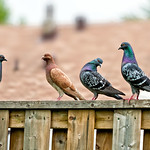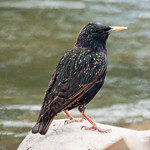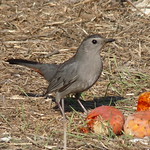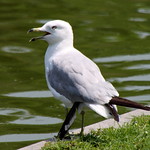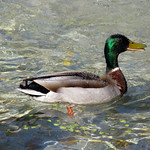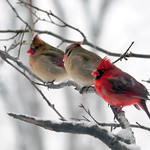|
Special Features





Image Libraries


|
|
Blog
|

Gaithersburg’s Barnes and Noble is still open, but for how long? |
Large bookstores fill an important niche in our cities. They’re some of the best places for people to hang out, kill time, and meet friends. But with Borders gone and Barnes and Noble stores rapidly disappearing, how will that niche be filled in the future?
To be sure, there are many other types of these “third places” in cities, ranging from coffee houses to public plazas, but bookstore’s particular combination of a climate controlled indoor space, with clean bathrooms, plenty of comfy seats, a pleasant cafe, and an endless supply of reading materials, has proven very popular.
Unfortunately, retail locations large enough for that kind of bookstore are expensive, and it doesn’t help Barnes and Noble’s bottom line if most of its customers are sitting around not buying anything. So as popular as big bookstores are, they’re going out of business.
With a few exceptions, local non-chain bookstores generally aren’t set up to fill this niche either, because they don’t usually have very many places where it’s comfortable to sit for long periods of time. Those easy chairs and wide open spaces in Barnes and Noble make a big difference.
Libraries could be a perfect replacement. After all, the whole point of libraries is to provide a place for people to read for free. Unlike bookstores, it doesn’t matter to libraries if customers only want to hang out.
But libraries will need to evolve to fill this role. The branch libraries in most cities have been losing to bookstores because they don’t have the right amenities. Libraries will need to be bigger, with more of the magazines and coffee table books that people enjoy flipping through in bookstores. Libraries will need cafes, and a more fun, less stodgy character overall.
Some of the new central libraries in big cities are taking on this role, but it won’t help too much to only have 1 big nice library in each metropolitan area. If libraries can do this, it will be the smaller neighborhood branches that make most of the difference. They’re the ones that will have to change the most, and that could reap the most benefit.
Average Rating: 4.6 out of 5 based on 253 user reviews.
October 31st, 2012 | Permalink
Tags: development, proposal

There was a flurry of activity on twitter Sunday, with posts about DDOT installing the western half of the L Street cycle track. It looks to be in from New Hampshire Avenue east to about 16th Street.
I’ve probably never advocated for slower installation of bike infrastructure before, but hopefully DDOT will wait until the hurricane is past before finishing.
In the mean time, here’s the cycle track just west of Connecticut Avenue. I went to check it out yesterday just as the rain was starting. You can find more pictures at GGW.
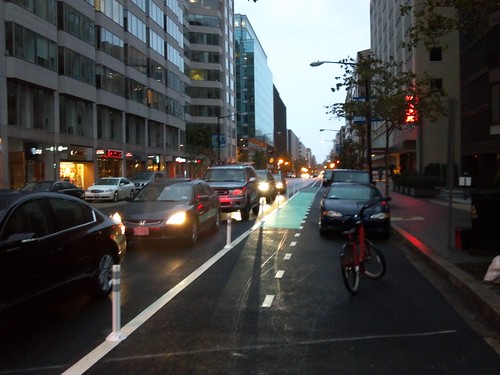
The cars at right are in what used to be the parking lane, but what will soon become the left turn lane onto Connecticut Ave.
Average Rating: 4.7 out of 5 based on 295 user reviews.
October 29th, 2012 | Permalink
Tags: bike, transportation


|
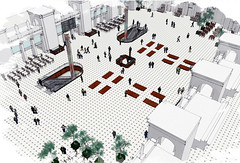
The proposed redesign. |
The Main Hall at Washington Union Station is undergoing a redesign that will eliminate the Center Cafe, punch holes in the floor for escalators to the lower level food court, and change the room’s furniture layout. The comment period for the redesign proposal ends tomorrow November 15, so now is the time for anyone interested to take a look, and send in comments.
The gold-trimmed Main Hall is a fantastic and beautiful civic space, recent scaffolding aside. It’s one of the best Beaux Arts rooms in America, and is lively with visitors through long hours of the day and night. It’s a space that is working very well already, so any changes need to be carefully considered.
The hall was temporarily ruined by a poorly-conceived redesign in the 1970s. If project architects get too carried away with changes, the same could happen again.
The good news is that the redesign being proposed now is relatively restrained. That wasn’t always the case. The first proposal back in 2010 would have overwhelmed the historic character of the Main Hall with a clashing metal and glass structure in the center of the room. Two years later, the new proposal is a lot better. It makes less significant changes, and leaves the aesthetic focus of the hall where it belongs, on the world-class Beaux Arts features.
The proposed escalators down to the food court are a little troubling, because punching holes in the floor of such a grand space sounds very similar to the 1970s mistake. On the other hand, without the Center Cafe in that space the Main Hall may seem too large, maybe even a little barren. There needs to be something in about that location that breaks up the floor mass. Both the raised cafe and holes for escalators would be too much, but one or the other is just about right.
The escalators will also improve circulation in the station, and add a new reason for visitors to go through the Main Hall.
The 2010 escalator proposal was garish and inappropriate, but this new redesign is subdued enough that the benefits it brings are worth the trade-offs.
Except for the signs. The signs are awful.
The escalator proposal also includes a pair of vertical signs, sticking out from the holes in the Main Hall floor and up in to the middle of the room. This is actually a great idea, because a vertical element fills the huge room volume a bit, and something near the center of the hall adds a focal point. Unfortunately, the design of the signs themselves is all wrong.
Take a look:
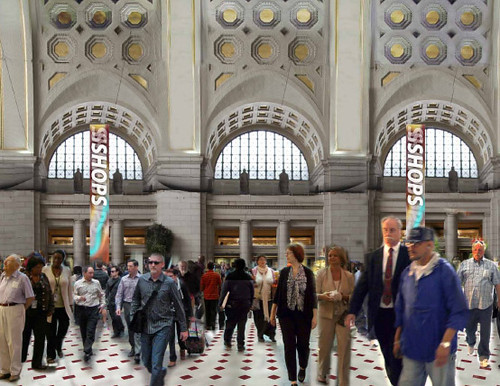
Rendering of the proposed redesign, showing large LED signs.
Talk about clashing!
LED signs that look like they came straight from a suburban strip mall aren’t right for one of the most famous Beaux Arts rooms in America. A vertical element that incorporates signs would be good there, but the design needs to be improved.
A better option would be to go with something dignified and ornate, that stands out but also works with the room’s historic character. Something like an iron street lamp with a banner attached would look great, and be far more appropriate for the context.
For more details on the proposed redesign, visit the Union Station Redevelopment Corporation. If you want to comment you can use the form on that site, but be sure to get your thoughts in by Thursday, October 25 November 15.
Update:According to an email from Union Station Redevelopment Corporation representative Lisa Klimko, the comment deadline has been extended to November 15.
 Cross-posted at Greater Greater Washington. Cross-posted at Greater Greater Washington.
Average Rating: 5 out of 5 based on 167 user reviews.
October 24th, 2012 | Permalink
Tags: architecture, development, preservation

I’ve installed a new commenting system, using the Disqus platform. I’ve noticed that it doesn’t update the number of comments that have been made on a post right away, but other than that it seems to work fairly well, which is a big improvement from the not working at all status of comments for the past couple of weeks. Unfortunately the old comments are lost.
The commenting problem was actually only the most visible aspect of a whole series of back-office technical problems that had to be worked out, but hopefully everything is ship shape now. Hopefully.
Average Rating: 4.6 out of 5 based on 278 user reviews.
October 23rd, 2012 | Permalink
Tags: site

On Monday DDOT began construction of the long-awaited L Street cycle track, which when complete will instantly become the best way to bike east through downtown Washington.
The final design of the cycle track includes an adjustment that BeyondDC recommended last May: extending the high-visibility green-painted section into the conflict area where cars cross over the cycle track in order to turn left. Here’s DDOT’s original design from May, with the final design below:
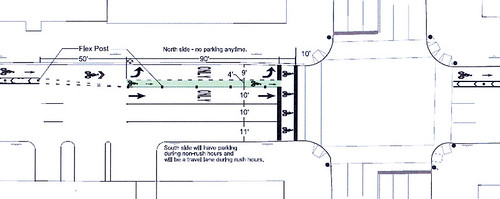
Original design.

Final design.
The main purpose of the green paint is to increase visibility at conflict points between cars and bike lanes, so painting the crossover point along the cycle track is a natural idea. It looks like DDOT will use the same hatching pattern they use at R and Connecticut, which seems to work well.
Kudos to DDOT for making the adjustment, and especially for moving forward with construction.
Now hopefully the M street cycle track, L Street’s westbound twin, will move forward quickly. I have a feeling that L Street, which is supposed to be one-way only, will have a lot of reverse direction riders until M Street opens.
Average Rating: 5 out of 5 based on 279 user reviews.
October 22nd, 2012 | Permalink
Tags: bike, transportation

Good news: The Dupont Circle south escalator is open and working again! 8 long months later, it’s good as new. Yay!

Dupont south.
Bad news: In order to improve safety on the Pennsylvania Avenue cycle track, on Friday DC placed signs reminding drivers not to attempt U-turns through the bike lanes. Unfortunately, the “no U-turns” signs were placed in the bike lanes, blocking them to bicyclists. Oops.
Update: The sign has been moved.

Pennsylvania Avenue oopsie. Photo via @BicycleSPACE on twitter.
The latter duplicates a classing lulzy internet “fail” image, from Dana Point, California:

Original source unknown.
Average Rating: 4.7 out of 5 based on 150 user reviews.
October 22nd, 2012 | Permalink
Tags: bike, development, metrorail, transportation

Washington’s growing fleet of water taxis are useful as transportation, but they’re also a fun and unique way to see the city. I used an American River Taxi to travel to a Nationals game a few weeks ago, and photographed the trip for posterity.
ART ferries sailing to the ballpark pick up passengers at Washington Harbor, in Georgetown. Boats pull directly up to the boardwalk, and passengers simply walk straight on.
 The ferry. The ferry.
More pictures after the jump.
> Continue reading
Average Rating: 4.8 out of 5 based on 288 user reviews.
October 18th, 2012 | Permalink
Tags: boat, galleries, transportation

|
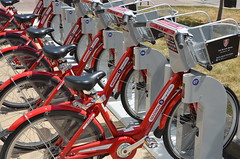
Madison B-cycle bikes. Photo by afagen on flickr. |
So far almost all the bikesharing systems in the US have been implemented by one of two companies, B-Cycle and Alta Bicycle Share. Alta produces Bixi bikes, which are used by Capital Bikeshare, as well as the bikes in place or planned in New York and Boston. Baltimore on the other hand had been planning on using B-Cycle, but now appears to be switching gears and may flip to Alta.
Apparently Baltimore’s deal with B-Cycle was premised on finding private funding, and had a time limit that has since expired. With funding not yet identified they have to take a step back and negotiate a new contract. That gives them the opportunity to reconsider Alta, which is on the table.
If Baltimore does use the Alta/Bixi system, it might be possible to cross-honor memberships with Capital Bikeshare, allowing Baltimore members to ride in DC and vice versa. Baltimore’s transit Charm Card and WMATA’s SmarTrip cards can already be used in both places, so doing the same with bikesharing makes a ton of sense. And with New York and Boston using the same system, it’s possible that one day Capital Bikeshare members might be able to use bikes all up and down the east coast.
Average Rating: 4.5 out of 5 based on 157 user reviews.
October 17th, 2012 | Permalink
Tags: bike, transportation

Last year about this time I visited Seattle, Portland, and Vancouver. I prepared a slideshow of transportation photos from the three cities to share with coworkers. It’s essentially a tour of rail, bus, and bike infrastructure within each city. Why not share it here too?
Click the image to download a pdf of the slideshow. It’s about 16 Mb. If you just want to see the photos in flickr without commentary, here they are.
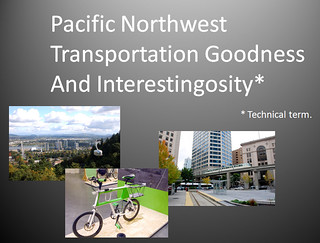
Click to download pdf.
Average Rating: 4.6 out of 5 based on 266 user reviews.
October 16th, 2012 | Permalink
Tags: bike, boat, BRT, bus, commuterrail, galleries, intercity, lightrail, streetcar, transportation

|
Media





Site
About BeyondDC
Archive 2003-06
Contact
Category Tags:
Partners
|












